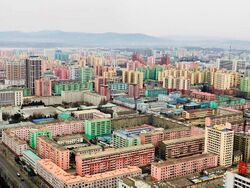Minxia City
Script error: The module returned a nil value. It is supposed to return an export table.
Minxia City | |
|---|---|
| 闽夏市 | |
 Colorful buildings in Minxia City | |
| Founded | 1968 |
| Government | |
| • Mayor | Mei Wang |
| Population (2027) | |
| • Total | 1,470,698 |
| Website | www.minxiacity.com.cr |
Minxia City is a planned city in northwestern Daxia and capital of the province of Mung with a population of approximately 1,470,000 people according to the 2027 general census. Nestled deep in the Arik Mountains, extensive road and tunnel construction was needed to make transport to and from Minxia economically viable, so much so that it is now a critical transport junction for the transport of goods to neighboring Canpei. The city has a total land area of 1,065,353 km2. The city is the center of the country's phosphate production operations. Founded in 1964 as a planned settlement by the Department of Mineral Exploration to house the workers of the nearby phosphate mines, the city has grown and continued to thrive from this single industry, leading it to be known as the 'Fertiliser Capital of Daxia. Starting in the decade of the 1990's, steel mills also began to operate in the outlying districts, cementing Minxia as a top industrial city of the northwest. Minxia City is among the top ten most polluted cities in Daxia, the use of face masks is widespread in the city to prevent respiratory diseases.
Often derided as a bleak industrial city (despite periodic initiatives by local government to paint buildings in bright colors), Minxia City does offer a variety of interesting sights and recreational activities for visitors. There are several museums dedicated to the mining activities, such as the Minxia Geological Museum and the Museum to Phosphate Pioneers. The Chouyun mine ceased operations in 2005 and has been converted into a tour experience through the tunnels and mine shafts. Minxia is also home to the sludge filled Lake Zhenzhu, one of the man made wonders of the modern world. The city has an active nightlife scene, with ubiquitous karaoke bars where locals and tourists mingle freely.
Economy
Culture
Education
Minerals institute
